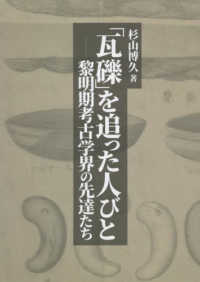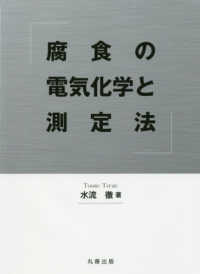- ホーム
- > 洋書
- > 英文書
- > Science / Mathematics
Full Description
The systematic investigation of self-diffusion and impurity diffusion in metals began as a result of the availability of a wide variety of artificial radio- isotopes following the Second World War. During the following years, rapid advances in the theory of solid-state diffusion and the ever-increasing number of experimental data were comprehensively described in any number of textbooks and review papers. But impurity diffusion in metals was more or less superficially treated in the textbooks, and some of the review papers, with the result that - even up to now - a comprehensive review of the correct interpretation of impurity diffusion in metals has been lacking.
Contents
Introduction: Early Results of Diffusion Investigations in Metals
Introduction: Experimental Techniques
Diffusion Mechanisms: The Vacancy Diffusion Coefficient
Diffusion Mechanisms: Two-Defect Models
Diffusion Mechanisms: One-defect models
Self-Diffusion: Self-Diffusion in FCC Metals
Self-Diffusion: Self-Diffusion in BCC Metals
Self-Diffusion: Point Defect Investigations
Self-Diffusion: Comparison of the results of diffusion and point defect investigations
Self-Diffusion: Concluding Remarks on Self-Diffusion
Impurity Diffusion: Empirical Correlations
Impurity Diffusion: Impurity Diffusion in Noble Metals
Impurity Diffusion: Impurity Diffusion in the 3d Metals of Group VIII
Impurity Diffusion: Impurity Diffusion in Hexagonal Metals
Impurity Diffusion: Impurity Diffusion in Aluminum
Impurity Diffusion: Impurity Diffusion in Lead
Impurity Diffusion: Impurity Diffusion in Refractory BCC Metals
Impurity Diffusion: Impurity Diffusion in the BCC ß-Phase of Group IV Metals
Impurity Diffusion: Concluding Remarks on Impurity Diffusion








